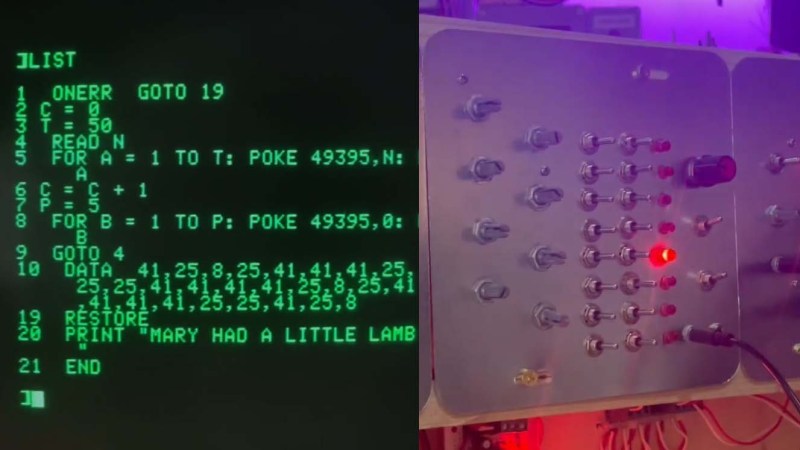We have a soft spot for synthesizers – seriously, who doesn’t? So when [Joshua Coleman] combined his retro-looking DIY modular synth with the equally retro Apple II computer, we just had to share it with you.
The two machines are paired using a vintage digital-to-analog logic controller pack. This DAC was originally used to control model trains using your Apple II – something that we now desperately need to see in action. The pack can output voltages between 0 and 2.55 V at 8-bit resolution (or 256 steps), which is plenty for a retro synth.
With the card installed in Slot 7 of the Apple II and the DAC wired through to the synth’s CV/gate, it’s then a trivial matter of writing POKE statements in Applesoft BASIC to control the synth. The video after the break demonstrates playing a simple melody, as well as how one might use the Apple II keyboard to ‘play’ the synth in real time.
If you’re interested in building your own, the video below has all the information needed, as well as helpful advice on where to find a DAC for your preferred model of vintage computer. If all that doesn’t tickle your musical fancy, make sure to check out our coverage on the Game Boy MIDI synth, or perhaps this peculiar synth and visualizer combo.















I miss Apple II BASIC. 😪
I wish I could learn Python or such as easily as I did that language during my early teens…
I’ve been told to try OCAML instead….
Take a look at the Colour Maximite by Geoff Graham. It gives you that same hands on feel but with better graphics and a much greater speed. You’ll have to build your own thanks to the chip shortage, but chips are available on aliexpress and it’s essentially a single chip BASIC computer.
depending on what you want to do, you could learn something more obscure but perhaps leverages your prior knowledge and requires less investment of your time. Such as Blitz BASIC and its children. https://blitzresearch.itch.io/
Blitz is good for writing toys and 2D games and just general sorts of calculation utilities that we used to use our computers for back in the day.
But there are a lot of other languages out there that are useful and easy. People love Python, but it can get deep and you’d need to stay on top of the changes in the industry and available libraries.
A practical and equally popular choice to Python is JavaScript/NodeJS. It has messy C-like syntax, but it is widely deployed. You can sit down in front of any browser on any device and use it. It has similar problems with the need to track what the latest libraries and techniques are “industry standard”, but old versions of JavaScript are still widely supported unlike old versions of Python. It isn’t too big of a deal to write new software for a 10 year old JavaScript environment, if you so choose. By that assumption, I think decades from now it’s likely that some old JavaScript software will still be pretty straight forward to get up and running.
Other options would be: Lua, which powers the wonder LÖVE game engine and is also embedded in many programs; Factor, a FORTH-like IDE with some powerful data types and type checking and good performance; Pharo, a self-contained SmallTalk environment.
Syntax-wise I think Forth, Tcl, or SmallTalk have a shallower learning curve than Python or JavaScript (while uglier it is about as complex as Python). With Lua or Ruby being a sort of middle ground.